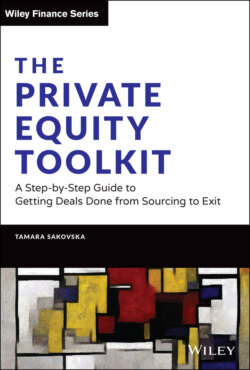Читать книгу The Private Equity Toolkit - Tamara Sakovska - Страница 32
2. Conduct an in-depth analysis of the selected industry
ОглавлениеThe objective of this step is to evaluate the attractiveness of the sector, learn about its structural features and identify profitability drivers. It is a dynamic exercise: even the most comprehensive attempt at answering all major questions about the industry will leave you with some information gaps. As you talk to sector experts and company executives, you will be able to fill these gaps and generate your own insights that will help you to come up with an actionable investment thesis.
I describe my own approach to industry analysis in broad terms below.
Sector scope. I find that an appropriate sector definition is key before beginning this analysis. This should generally focus on a relevant geography and include all companies producing the same product or service, as well as those companies offering viable substitutes.
External environment. What broad macro factors2 are likely to have an influence on this industry? Take note of any political considerations, economic trends, cultural influences, legal or environmental concerns that are important to this sector.
Sector performance. What is the total market size and historic growth rate? Is the industry new, mature or declining? What are the key drivers of projected growth? Is there a cycle and, if so, where are we now?
Demand factors. What secular trends are influencing demand? Who buys the product and how are purchasing decisions made? Is this a discretionary spend? What are the key determinants of demand as well as its historic and projected growth rates?
Supply factors. Understand sector capacity: historic, current and projected. What does the supply look like when broken down by product or service? Map out the industry's supply chain.
Competitive landscape. What is the market structure: fragmented or fairly consolidated? What are the market shares of top players? How attractive is the industry? To provide a comprehensive answer to this question, you may find it helpful to refer to the works of Porter (1985) and Grant (2002). In short, any industry analysis should aim to examine key sector forces3 such as barriers to entry, the degree of rivalry among competitors, supplier power and buyer power as well as the prevalence of product substitutes and complements.
Pricing. What grows faster: supply or demand? What side of the market has a greater influence on price? Are there any unusual factors influencing a free market price mechanism, like an ongoing price war, taxes, surcharges, government incentives or regulatory caps?
Typical cost structure. What is the ratio between fixed and variable costs? What are the historic and projected trends in the major cost categories? Are companies able to pass cost increases to buyers?
Industry operating metrics. What are the relevant aggregate sector statistics? What are the typical operating ratios at the company level? Is it a capital-intensive sector? Does the industry earn its cost of capital?
Sector risks and threats. What are key risks faced by the sector, such as regulatory, economic, political? Is there a threat of industry disruption, product obsolescence or technological change?
Key takeaways and next steps. Summarize the key insights relevant to your investment thesis to be confirmed in subsequent meetings with industry experts and companies. What are the recent sector developments or major sector news that you need to keep in mind? What are the gaps in the market data you have been able to gather?
These questions constitute the bulk of your research work and once you have gone through each one you will have learned a lot about the industry. Have you discovered any negative features of the sector, such as overcapacity, product commoditization, wild fluctuations in demand or major structural shifts? If, from the sources that you have reviewed so far, you come to a view that the industry is weak and not structurally suitable for private equity transactions, consider stopping your research at this stage. Making a private equity investment in a challenging sector is very risky and can make your life miserable down the road. Even teaming up with the world's most capable management team will hardly be enough to withstand the forces of abysmal industry fundamentals and it is best to stop work in order to avoid a potentially loss-making investment.
What sources can you utilize for your industry research, especially if you are on a limited budget? If there are publicly listed companies operating in the sector, I always find it useful to read reports prepared by equity research analysts that cover these companies. Typically, company initiation research reports tend to be quite comprehensive and feature a detailed industry section. It is also worth keeping an eye out for any up-to-date comments on the industry provided in the investor relations sections of websites of publicly listed companies as well as in their annual reports. Regulatory bodies, industry associations and trade journals may also publish extensive information about the sector.
Make sure to check out sources such as current news and in-depth articles about the industry as well. Is there valuable information you can gather from reputable industry blogs or relevant online business communities? If you have a budget for this project, you might decide to purchase extensive industry reports from specialized market research firms or hire strategy consultants to perform a tailored industry analysis for your fund. In case the sector becomes of significant strategic importance to your organization and there are imperative issues that you need to investigate, consider conducting a private survey4 that addresses your specific research questions.
